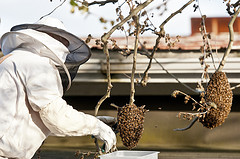4 Bizarre Bee Problems You Should Learn to Fix
 Bees are an amazingly diverse insect species, comprising some 20,000 different varieties. These flying creatures live wherever they have access to their food source -- flowering plants -- and are found on every continent but Antarctica. Although they play a crucial role in biodiversity, many humans dislike bees due to the painful stings with which they defend themselves. Beyond their stinging capability, bees can cause some lesser known disturbances. Here are 4 bizarre bee problems and how to deal with them.
Bees are an amazingly diverse insect species, comprising some 20,000 different varieties. These flying creatures live wherever they have access to their food source -- flowering plants -- and are found on every continent but Antarctica. Although they play a crucial role in biodiversity, many humans dislike bees due to the painful stings with which they defend themselves. Beyond their stinging capability, bees can cause some lesser known disturbances. Here are 4 bizarre bee problems and how to deal with them.
1. Round holes appear in your wooden siding, window sills, trim, or deck … or piles of sawdust are found nearby. A carpenter bee infestation may be the source. Carpenter bees dig into wood to make their nests. This is fine in the wild, where they bore trees and stumps, but when they gash ugly holes in your house, it becomes an annoyance. The nuisance factor is increased by the fact that woodpeckers enjoy eating carpenter bee larvae and will gouge their way into the bees’ tunnels to scoop up this delicacy. Spraying insecticide is bad for the environment and beneficial wildlife. Instead, you can buy or build wooden carpenter bee traps, which don’t attract other non-drilling types of bee.
2. Drunken-seeming bees flock around the base of one of your trees, accompanied by a smell of beer. When a tree is wounded due to unskillful pruning, natural cracking, or insect damage, oozing sap results. If the sap becomes infected, it will be acidic or … hic! … alcoholic. This condition, known as slime flux, attracts not only sweet-loving bees of various kinds but also beetles, butterflies, ants, and worms. It tends to affect maple trees, poplars, and large oaks especially. To discourage the insect revelry and protect your tree from further harm, wash down its trunk with a mild bleach solution.
3. Mud is found in an outdoor electrical outlet, air conditioner, or heating unit. You might have a honey bee nest on your hands. Honey bees like to nest in dark spaces, like the inside of a hollow tree -- or your HVAC housing. Removing a colony that's taken up residence is a tricky business, due to the combined problems of warding off stings, protecting against electrical shock, and avoiding harm to the bees. Africanized bees, which live mainly in southern states, are particularly dangerous because they're more aggressive than other honey bees. You may need to hire a pest control expert and an electrician. To prevent this type of infestation, buy insect-proof electrical equipment and keep the cover closed. You may screen or seal existing equipment, but be careful not to interfere with essential ventilation.
4. Feral bees are swarming on your property. A swarm of hundreds or even thousands of bees clustered in your backyard is an impressive and perhaps frightening sight. However, honey bees are unlikely to hurt human beings if you stay out of their way, especially when they are swarming and do not have any young to protect. Because of the declining honey bee population due to pesticide spraying and colony collapse disorder, it's vital to preserve any swarms of these precious honey producers and pollinators. In fact, honey bees are a protected species in many areas. An experienced local beekeeper will be delighted to take them off your hands and will know the correct procedure for dealing with them safely. Act swiftly before the colony decides to move into a corner of your home.
Laura Firszt writes for networx.com.
Updated April 17, 2018.
Looking for a Pro? Call us (866) 441-6648

Pest control Average Costs
Exterminators Experiences

Mouse Control Included Traps And Exclusion

The Best Pest Control Service For My New Florida Home



